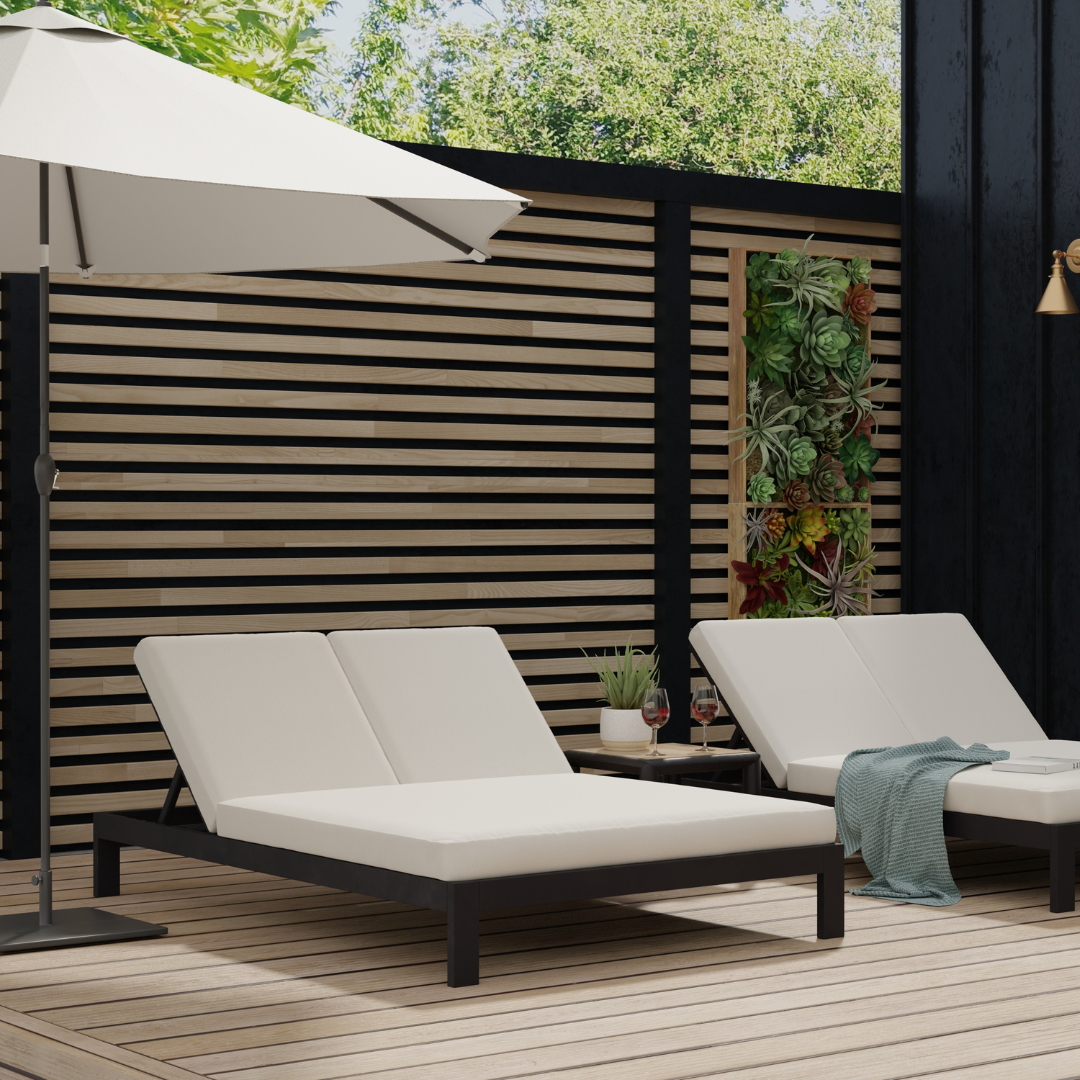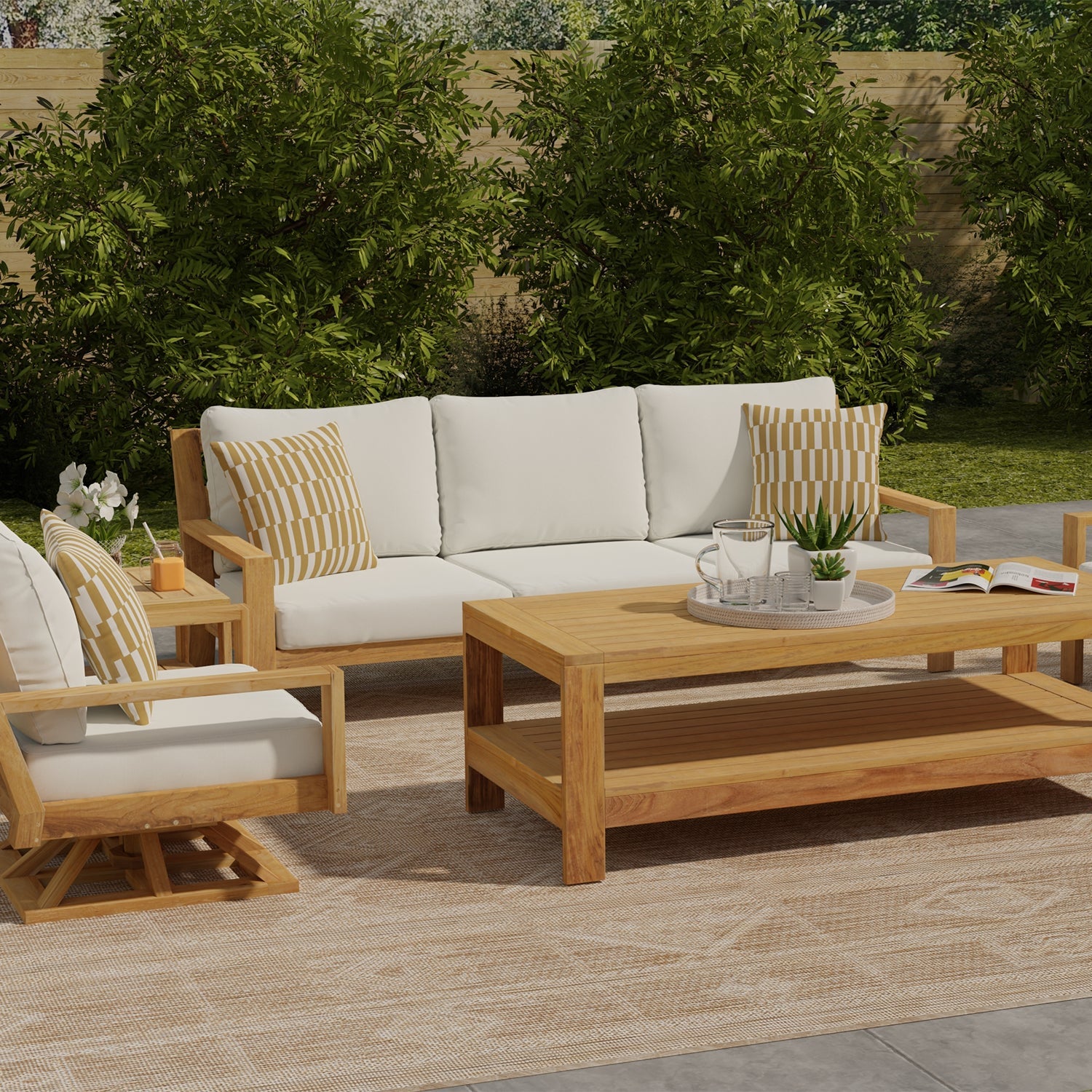As the outdoor temperatures start to drop and the days become shorter, it’s time to start thinking about winter preparations. When it comes to your patio, doing some prep work ahead of time is the key to preserving your outdoor furniture and more. Read on to learn a few simple tips on what to do with outdoor patio furniture in the winter months.
How To Prepare Your Patio For Winter: Start by Cleaning
The first thing you should do to prep your patio for the upcoming winter months is to do a thorough cleaning. Start by washing off your patio with a garden hose or pressure washer and remove all dirt and excess debris.
Now is also a good time to go ahead and pick up loose branches and twigs so that everything is nice and clean. If you have trees with dead or rotting branches, trim them now before it gets too cold. Finally, clean off all of your patio furniture so that it’s ready for winter storage. Use a mixture of mild dish soap and water to rinse off wicker furniture gently.
If you have teak wood furniture, always be sure to follow the cleaning instructions carefully to ensure that the furniture doesn’t get damaged. For aluminum outdoor furniture, check out our blog on How To Clean Powder Coated Aluminum Patio Furniture for advanced cleaning tips.
How to Winterize Patio Furniture
To properly winterize your outdoor patio furniture, you must first familiarize yourself with your outdoor set and learn what kind of care each piece requires. Though pairing wicker chairs with a snappy teak wood table feels like a no-brainer, you shouldn’t mix up their cleaning routines. Knowing how to protect outdoor furniture in winter becomes a breeze once you’ve mastered each aspect of the materials.
First, let’s identify some key differences.
Teak Furniture
Can patio furniture get wet? Some types handle moisture better than others. Teak furniture remains a popular choice for patios due to its resilient nature and chic look. Many consider teak more sturdy and reliable than other types of wood furniture, as they’re not as susceptible to swelling or warping.
However, it’s wise to keep your eyes peeled for any signs of dirt or dampness. Mold and mildew can manifest on teakwood if you’re not careful. This fungus can affect not only the chair’s integrity but also the smell of your furniture.
Luckily, you can take matters into your own hands this winter. Preventative action is one of the best ways to counteract mold and mildew. You can fight against unwanted buildup by regularly cleaning your teak. Wondering how to clean patio furniture? It's a good idea to clean them thoroughly; combining warm water with vinegar should do the trick.
Wicker Furniture
Wicker furniture makes an excellent lightweight chair for those breezy summer months. When winter rolls around, however, wicker can take on some serious damage if you’re not careful.
Before you start cleaning your wicker, you must first ask yourself a crucial question: what type of wicker do I have? While natural and synthetic wicker may look similar, their requirements for cleaning can differ significantly.
- Natural wicker/rattan – While gorgeous, natural wicker tends to chip over time. To keep it looking at its best, clean it with a small amount of oil-based soap and warm water and gently scrub with a damp cloth. Don’t overdo the rinse. A gentle misting with your hose or spray bottle should do the trick. Finally, dry your wicker with a warm towel or lay it in the sun.
- Synthetic wicker/resin wicker – Synthetic wicker is typically easier to clean due to its weather-resistant coatings. Since it has built-in protection, you can spray down your furniture with soap and water and let it air dry.
Whether your wicker comes with a natural sealant or needs a little love, it can last for years as long as you implement routine checkups and regular cleaning.
Aluminum Furniture
If you’ve got an aluminum furniture set on your back patio, you’ve made a wise move. Not only does aluminum make sturdy and stylish furniture, but it’s also almost entirely rust-proof. However, while you can say good riddance to rust, there’s another winter warning you should consider.
When the winter weather fluctuates, aluminum can expand, and residual wetness can get inside your furniture through holes and water drains. Over time, changes in temperature and precipitation can compromise the furniture’s frame, leaving it more unstable. By summertime, your chairs and table may feel extra wobbly or unbalanced.
While the best way to deter warping is to store your furniture indoors, you can take a few other preventative measures. First, keep an eye out for any holes or scratches (which may make your aluminum furniture more vulnerable to wetness) during your routine furniture cleaning. If you spot any, feel free to touch them up with paint. If you want to double down on protection, car wax also works wonders to seal weak points.
Outdoor Fabrics/Covers
Outdoor fabrics do more than round out a color palette. They combat external damage with their weather-resistant fibers. While they can withstand a certain amount of rain and ice, it’s still wise to take protective measures to ensure their integrity. Extreme elements and wintry conditions can still introduce dirt, fading, ripping, and wear to even the most resilient material.
Like aluminum furniture, fabrics should move inside during harsh winter storms. Placing your sofa cushions in a large plastic bag can shield them from the elements. However, if you cannot move them, proper cleaning can undo plenty of damage. In fact, most outdoor fabrics make cleaning a breeze.
Depending on the severity of damage to the fabric, you can employ a variety of methods to banish stains for good:
- Machine washing – If your fabric needs some freshening up, odds are you can toss it in the washing machine. Make sure to double-check the labels on your items before heading towards the laundry room and take heed of any specific instructions.
- Spot cleaning – Notice a few specks and stains on your fabric? Not to worry. You can clean most small stains in a pinch with vinegar and water. Combine ¼ cup of distilled white vinegar with 4 cups of warm water. You can use this solution to spray on your fabric or even use a toothbrush for those stubborn stains.
- Cleaning oil – If you have oil stains on your fabric, you’re likely due for a deep clean. Luckily, it’s nothing a little cornstarch can’t fix. Lightly dust some cornstarch and baking soda on the stain and wait about 15 minutes. Gently scrape off the dust and repeat as needed.
A little TLC goes a long way. Check out our blog on How To Clean Patio Furniture Cushions and Canvas for more insider tips and tricks.
Store your Patio Furniture Safely
Protecting your outdoor furniture is crucial as you think about how to prepare your patio for winter. If you have the space, storing everything inside a garage or shed is the best way to keep it protected during cold winter. Check your shed or garage carefully for leaks and gaps before you store your furniture inside. This will ensure that everything stays dry and free of pests until springtime comes around.
If you don’t have storage space for your patio furniture, it’s important to protect each piece of furniture with quality, weatherproof furniture cover. Remove all of the outdoor cushions from your furniture and bring them inside. You can place the cushions in the attic or basement as well as in a large closet if you have room to protect them from fading and getting wet. Our patio chairs and other furniture include outdoor cushions with lifetime warranties so you can rest easy.
More Quick Preparation Tips
Before winter arrives, you should ensure all of the outdoor furniture on your patio is ready to be cleaned and stored. Now is the time to get rid of some items that you may no longer want or need. Once you declutter and clean your outdoor living space, make sure that everything is completely dry before you put it away. It’s also a great time to check your roof, gutters, and downspouts to look for signs of damage. Getting these items repaired now will protect your patio and your home. Look at the patio concrete, driveway, and walkway to ensure that everything is in good condition. Repair cracks and potholes now, so you’ll have a beautiful patio waiting for you when the cold weather warms up again.
Sources:
Alumeco Group. Thermal Expansion. https://www.alumeco.com/knowledge-technique/general/thermal-expansion/
Better Homes & Gardens. How to Clean Outdoor Cushions and Pillows to Keep Them Fresh All Season. https://www.bhg.com/home-improvement/porch/outdoor-rooms/how-to-clean-outdoor-cushions/



